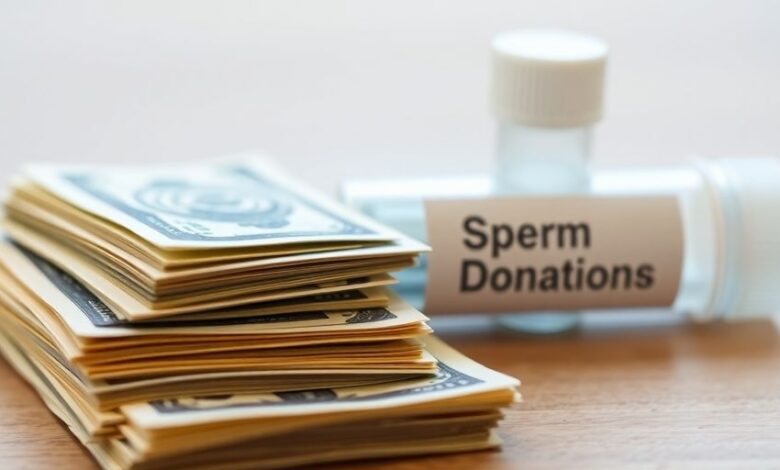
Have you ever wondered how much do sperm donors get paid? The compensation rates for sperm donation can vary quite a bit based on several factors. In this article, we will break down what sperm donors can expect to earn, explore the payment structures, and look at the legal and ethical aspects of sperm donation in 2025. So, whether you’re considering becoming a donor or just curious about the process, this guide has got you covered.
Key Takeaways
- Sperm donors can earn between $50 to $1,500 per month depending on the sperm bank and location.
- Factors such as donor health, frequency of donations, and regional differences can affect compensation rates.
- Payment structures vary, with some banks offering per donation payments and others providing monthly stipends.
- Legal regulations around sperm donation can influence how much donors are compensated, with some countries prohibiting payment beyond expenses.
- Sperm donation not only provides financial benefits but also helps families achieve their dreams of parenthood.
Understanding Sperm Donation Compensation
Average Earnings for Sperm Donors
So, you’re thinking about becoming a sperm donor and wondering about the money? Let’s get real. The pay can vary quite a bit. Most sperm banks don’t exactly advertise huge payouts, but it’s a way to earn some extra cash while helping people start families. Generally, you can expect to make somewhere between a few hundred dollars to maybe $1,500 a month. It really depends on how often you donate and the specific sperm bank’s policies. Some banks might offer bonuses for meeting certain criteria, like having high-quality sperm or being a specific ethnicity that’s in demand. It’s not a get-rich-quick scheme, but it’s a decent way to supplement your income. Keep in mind that the compensation is designed to acknowledge the time and effort involved in the process, not to exploit anyone. For example, fertility treatments may be covered by some sperm banks.
Factors Influencing Payment
Okay, so what actually determines how much you get paid? Several things come into play. First off, the location of the sperm bank matters. Big cities or areas with a high demand for donors might offer more. Your ethnicity can also be a factor, as some ethnicities are more in demand than others. The quality of your sperm is a big one – if your sperm count and motility are high, you’re more likely to get better compensation. Also, the sperm bank’s specific policies and payment structure will influence your earnings. Some banks offer a flat fee per donation, while others might have a tiered system based on sperm quality or other factors. Here’s a quick rundown:
- Location of the sperm bank
- Sperm quality and quantity
- Ethnicity and physical characteristics
- Frequency of donations
- Specific sperm bank policies
It’s important to remember that sperm banks aren’t just looking for anyone. They have pretty strict requirements, and only a small percentage of applicants actually get accepted into the program. So, while the money is a nice perk, it’s not guaranteed, and you’ll need to meet their criteria to qualify.
Payment Structures Across Different Banks
Each sperm bank has its own way of doing things when it comes to paying donors. Some offer a set amount per donation, usually ranging from $70 to $150. Others might have a more complex system that takes into account things like sperm quality, donor availability, and the number of vials produced per donation. Some banks also offer bonuses for things like referring new donors or completing a certain number of donations within a specific timeframe. It’s a good idea to shop around and compare the payment structures of different banks before committing to one. Make sure you understand exactly how much you’ll be paid per donation and what, if any, bonuses or incentives are available. Don’t be afraid to ask questions and get all the details before you sign up. You can also check guidelines for sperm donation to learn more about the process.
Comparing Sperm Donation Rates
Regional Variations in Compensation
Okay, so you’re thinking about donating sperm and want to know what the going rate is? Well, it’s not as simple as one price fits all. Where you live can seriously impact how much you get paid. For example, sperm banks in big cities or areas with a high demand might offer more to attract donors. Think about it: the cost of living is higher, so they need to make it worth your while. On the other hand, if you’re in a more rural area with less demand, the compensation might be a bit lower. It’s all about supply and demand, really. Keep in mind that these are just general trends, and it’s always best to check with local sperm banks for the most accurate information.
International Payment Standards
It’s interesting to see how sperm donation compensation varies around the world. In some countries, altruism is the main driver, and donors receive little to no payment, maybe just enough to cover expenses. Other countries have more established payment structures, similar to what you see in the US. Factors like healthcare systems, cultural attitudes toward donation, and legal regulations all play a role in shaping these international standards. It’s definitely not a one-size-fits-all situation globally.
Comparison with Egg Donation Rates
One thing people often wonder is how sperm donation pay compares to egg donation. Egg donation is generally compensated at a much higher rate. Why? Well, the egg donation process is way more involved and invasive. It requires medical procedures, hormone injections, and a longer time commitment. Sperm donation, on the other hand, is relatively simple and less time-consuming. So, while both are valuable contributions to helping families, the compensation reflects the difference in effort and risk. The global egg donation market was estimated to be worth $5.8 billion by 2027, which shows how high the demand is.
It’s important to remember that sperm and egg donation are different processes with different levels of commitment and risk. The compensation reflects these differences, but both are valuable ways to help people build families.
The Sperm Donation Process Explained
Initial Screening and Requirements
So, you’re thinking about becoming a sperm donor? Well, it’s not as simple as walking in and, well, you know. There’s a pretty thorough screening process involved. Think of it like applying for a job, but instead of your resume, it’s your genetic history.
First off, they’ll want a complete medical history, including your family’s. They’re looking for any hereditary conditions that could be passed on. Then comes the physical exam and a bunch of blood tests. They’ll screen you for all sorts of things, from HIV and hepatitis to genetic disorders. Some banks even do psychological evaluations to make sure you understand the emotional and legal implications. It’s a lot, but it’s all to ensure the health and safety of everyone involved. Some sperm banks approve fewer than 1% of applicants.
Donation Frequency and Limits
Okay, so you’ve passed the screening – congrats! Now comes the actual donation part. But there are rules about how often you can donate. It’s not like you can just show up every day. Typically, you’ll be asked to donate once or twice a week. This is to allow your sperm count to replenish and maintain its quality. Sperm banks also have limits on how many times your sperm can be used. This is to prevent accidental consanguinity (that’s a fancy word for people being related without knowing it). The exact number varies, but it’s usually around 25 families per donor.
Compensation Timing and Methods
Let’s talk about the money. You’re not doing this for free, right? The compensation timing and methods can vary a bit depending on the sperm bank. Generally, you’ll get paid per donation. The amount can range from $50 to $100 (or maybe a bit more) per sample. Some banks pay after each donation, while others might have a monthly payment schedule. As for the method, most will offer direct deposit into your bank account, which is pretty convenient. Some might even offer a check if you prefer. Just remember, the money is taxable income, so don’t forget to report your earnings when tax season rolls around.
It’s important to remember that sperm donation isn’t just about the money. It’s about helping people who can’t conceive on their own achieve their dream of having a family. That’s a pretty amazing thing to be a part of, even if it does involve a bit of paperwork and some, ahem, personal contributions.
Legal and Ethical Considerations

Regulations Governing Payments
When it comes to sperm donation, the legal landscape is still catching up. In many places, there aren’t specific laws that dictate how much donors can be paid. This can lead to a bit of a Wild West situation, where different clinics have different rules and payment structures. Some countries have stricter laws about the number of offspring from a single donor to reduce the risk of accidental consanguinity, but others don’t. This lack of uniformity can create confusion and potential ethical issues. It’s a complex area, and the rules can vary a lot depending on where you are.
Ethical Implications of Compensation
The ethics of paying sperm donors is a hot topic. Some people think it’s perfectly fine, viewing it as compensation for time, effort, and the inconvenience of the process. Others worry that it could exploit vulnerable individuals, especially younger men who might be motivated primarily by money. There’s also the question of whether paying donors could lead to a situation where people aren’t fully informed about the potential implications of their donation. It’s a balancing act between compensating people fairly and ensuring that the process remains ethical and responsible.
Transparency in Sperm Donation
Transparency is super important in sperm donation. Donor-conceived people are increasingly speaking out about the need to know more about their origins. Some feel that anonymous donations can have negative psychological and medical effects, especially when they discover they have many half-siblings from the same donor.
It’s becoming more common to argue that donor-conceived individuals have a right to information about their biological parentage, even if donors were promised anonymity in the past. This shift towards openness is changing the landscape of sperm donation and raising questions about the rights and responsibilities of all parties involved.
Here are some things that are important for transparency:
- Accurate medical history reporting by donors.
- Open communication about the number of children born from a single donor.
- Access to non-identifying information about the donor for donor-conceived individuals.
Benefits of Being a Sperm Donor

Financial Incentives
Let’s be real, the money is a draw for many guys. While it’s not a fortune, sperm donation offers financial compensation that can add up. Think of it as a way to earn some extra cash while helping others. The amount varies, but you can expect to get paid per donation, and those payments accumulate over time. It’s a nice perk for something that doesn’t take too much out of your day.
Helping Families Achieve Parenthood
Beyond the money, there’s a really rewarding aspect to sperm donation: you’re helping people build families. For single women or couples facing fertility issues, sperm donation can be the only path to parenthood. Knowing that you’re playing a part in bringing a child into the world and fulfilling someone’s dream of having a family is a pretty amazing feeling. It’s a chance to make a real difference in someone’s life.
Health Screenings and Benefits
One of the lesser-known benefits is the thorough health screening you receive as part of the donation process. Sperm banks need to ensure the quality and safety of the sperm, so they conduct extensive medical and genetic tests. This means you get a free check-up and valuable insights into your own health. It’s a win-win situation:
- Regular STI testing
- Genetic disorder screening
- Semen analysis
Donating sperm isn’t just about the money or the health checks. It’s about offering a chance at happiness to those who might not otherwise experience it. It’s a unique way to leave a positive mark on the world, knowing you’ve helped create a family.
Risks and Downsides of Sperm Donation
While sperm donation offers many benefits, it’s important to consider the potential downsides before making a decision. It’s not all smooth sailing, and understanding the full picture is key.
Physical Health Risks
Generally, sperm donation is considered physically low-risk. The primary method of collection is masturbation, which doesn’t pose significant health concerns. However, frequent donations could lead to temporary discomfort or fatigue. It’s important to follow the sperm bank’s guidelines on donation frequency to minimize any potential strain. The process of sperm donation itself is pretty straightforward.
Emotional and Psychological Considerations
This is where things can get a bit more complex. The psychological impact of sperm donation can be significant for some men. Donors might experience a range of emotions related to the potential offspring and their genetic contribution. Some may feel a sense of pride in helping others, while others might struggle with the idea of children existing without their direct involvement. Counseling is often recommended to help donors process these feelings and understand the long-term implications of their decision.
It’s important for potential donors to carefully consider their motivations and emotional readiness before proceeding. Thinking about future scenarios, like the possibility of children contacting them later in life, is crucial for making an informed decision.
Legal Rights and Responsibilities
The legal landscape surrounding sperm donation can vary depending on the location. Generally, in cases involving anonymous donors through regulated sperm banks, the donor relinquishes all parental rights and responsibilities. However, with known donors, the legal situation can become more complicated. It’s essential to seek legal advice to establish clear agreements regarding parental rights, financial obligations, and the donor’s role in the child’s life. Here are some things to keep in mind:
- Varying state laws can impact donor rights.
- Contracts are essential for known donors.
- Anonymity agreements should be carefully reviewed.
Future Trends in Sperm Donation Compensation
Predicted Changes in Payment Structures
Okay, so looking ahead, the way sperm donors get paid might be changing. Right now, it’s mostly a set amount per donation, but we could see some shifts. Maybe some banks will start offering bonuses for donors who meet certain criteria, like having high-quality sperm or being in high demand. There’s also the possibility of tiered payment systems, where donors get more money the longer they stay with the bank. It’s all about keeping up with the demand and making sure it’s worth the donor’s time. The online tutoring opportunities could be a model for flexible compensation.
Impact of Technology on Sperm Donation
Technology is already changing so many things, and sperm donation is no exception. Think about it: online platforms could make it easier for donors and recipients to connect, potentially cutting out the middleman (the sperm bank). This could lead to more competitive rates for donors, as they’d have more control over their earnings. Plus, advances in sperm analysis and storage could also affect compensation. If technology makes it easier to preserve and use sperm, the value of each donation might increase.
Evolving Legal Frameworks
Legal stuff is always a bit of a moving target, and it definitely plays a role in how sperm donors are compensated. Right now, regulations vary quite a bit from place to place, but we might see more standardized rules in the future. This could include things like setting minimum compensation levels or establishing clearer guidelines around donor rights and responsibilities. It’s all about making sure everyone is protected and that the process is fair. For example, guidelines for sperm donation may become more standardized across states.
It’s important to remember that sperm donation isn’t just about the money. It’s about helping people build families, and that’s something that can’t be measured in dollars and cents. But fair compensation is still important, and it’s something that will likely continue to evolve in the years to come.
Here are some potential future trends:
- Increased transparency in payment structures.
- More emphasis on donor health and well-being.
- Greater use of technology to streamline the donation process.
Wrapping It Up
So, there you have it. Sperm donors can make anywhere from a few hundred bucks to about $1,500 a month, depending on where they donate and how often. It’s not a get-rich-quick scheme, but it can help out with some extra cash. Plus, donors often feel good knowing they’re helping people start families. Just remember, the pay isn’t the main reason most guys do it. It’s more about making a difference in someone’s life. If you’re thinking about donating, make sure to check the requirements and see what the local sperm banks offer. It’s a unique way to contribute, and who knows? You might just find it rewarding in more ways than one.
Frequently Asked Questions
How much do sperm donors typically earn?
Sperm donors usually earn between a few hundred to $1,500 each month, depending on the sperm bank and location.
What factors affect how much sperm donors are paid?
Several factors can influence payment, including the donor’s health, education level, and the specific sperm bank’s policies.
How often can a sperm donor give donations?
Most sperm banks allow donors to donate several times a month, but there are usually limits to ensure health and quality.
What are the main benefits of being a sperm donor?
Donating sperm can provide financial help, the chance to assist families in having children, and free health screenings.
Are there any risks involved in sperm donation?
While sperm donation is generally safe, there can be emotional and legal challenges that donors should consider.
What are the future trends in sperm donor compensation?
In the coming years, payment structures may change due to technology advancements and evolving laws around sperm donation.




One Comment